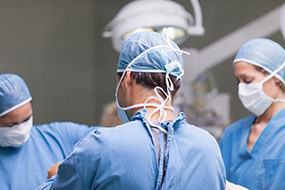-
Mark J. Downey, MD
10 Old Montgomery Hwy #200. Homewood, AL 35209
Appointments & Referrals: (205) 271-6511 - Schedule Now
Spinal Tumor Surgery
For patients with slow growing primary intradural spinal tumors such as meningiomas and schwannomas, surgery if often curative. The surgery involves the removal of the bony roof of the spinal canal (lamina) to expose the dura which is the covering of the spinal cord and nerve roots. The dura is then opened and the tumor is removed very carefully with the aid of the operating microscope and advanced microsurgical techniques. In order to ensure the highest level of safety during your surgery, the function of the spinal cord and nerves is routinely monitored during surgery. These intraoperative nerve monitoring techniques help the surgeon to avoid damaging nerves during surgery.

If you have a metastatic spine tumor (a tumor in the spine that began elsewhere in your body), surgery could potentially help to stabilize your spine, reduce pain, prevent paralysis, and increase your mobility. These tumors can be approached via an anterior, lateral, posterolateral or posterior approach. Sometimes following tumor removal, fixation of the spine using special instrumentation is required to redistribute stress on the bones and to keep them aligned. These palliative surgical techniques can provide local control of cancer while allowing the patient to return to other treatments such as chemotherapy or radiation. In some situations, spinal cord decompression is done to create enough space so that high-dose radiation can be given without putting the spinal cord at risk of significant injury.
Spinal angiography with tumor embolization is performed prior to surgery when dealing with tumors with an abnormally large number of blood vessels. In this procedure the blood vessels are identified by injecting dye into the tumor and then the interventional radiologist injects a special substance into the blood vessels to stop the blood flow. This procedure significantly reduces the risk of bleeding during surgery and is a very powerful adjunct in select cases of highly vascular spinal tumors.

Mark Downey, MD
As a physiatrist, Dr. Downey specializes in diagnosis and non-surgical treatment of pain-related spinal disorders. He is board certified in Physical Medicine and Rehabilitation (PM&R) since 2007 and uses his comprehensive spine and musculoskeletal training to determine the appropriate line of treatment for a variety of spinal conditions.
Testimonials
Home Remedy Book

As a community service, Spine Group Alabama mails out a free 36-page Home Remedy Book with customized stretches that can relieve some back and neck pain symptoms. Enter your name and address and we will mail you a copy.
Symptoms Chart

Some symptoms can become permanent if you don’t see the physician with in 24 hours. Find out when you can use “watchful waiting” and when you have an emergency symptom.
Need an Appointment?
Spine Group Alabama specializes in the treatment of back pain, neck pain, herniated discs, and all types of ligament strain related to the neck and low back. Spine Group Alabama is referred back and neck pain patients from across Alabama, including Birmingham, Tuscaloosa, Auburn, Huntsville and Montgomery.
Office Hours:
Monday - Thursday: 8am - 4:30pm
Friday: 8am - 2:30pm
Saturday/Sunday: Closed
(205) 271-6511

